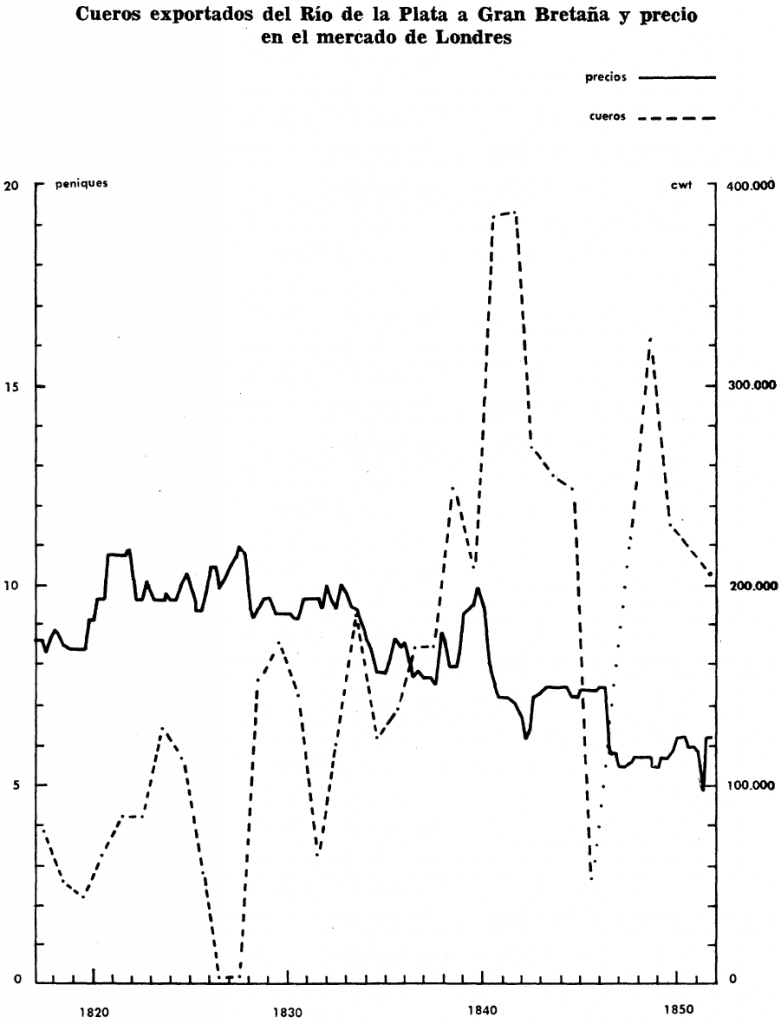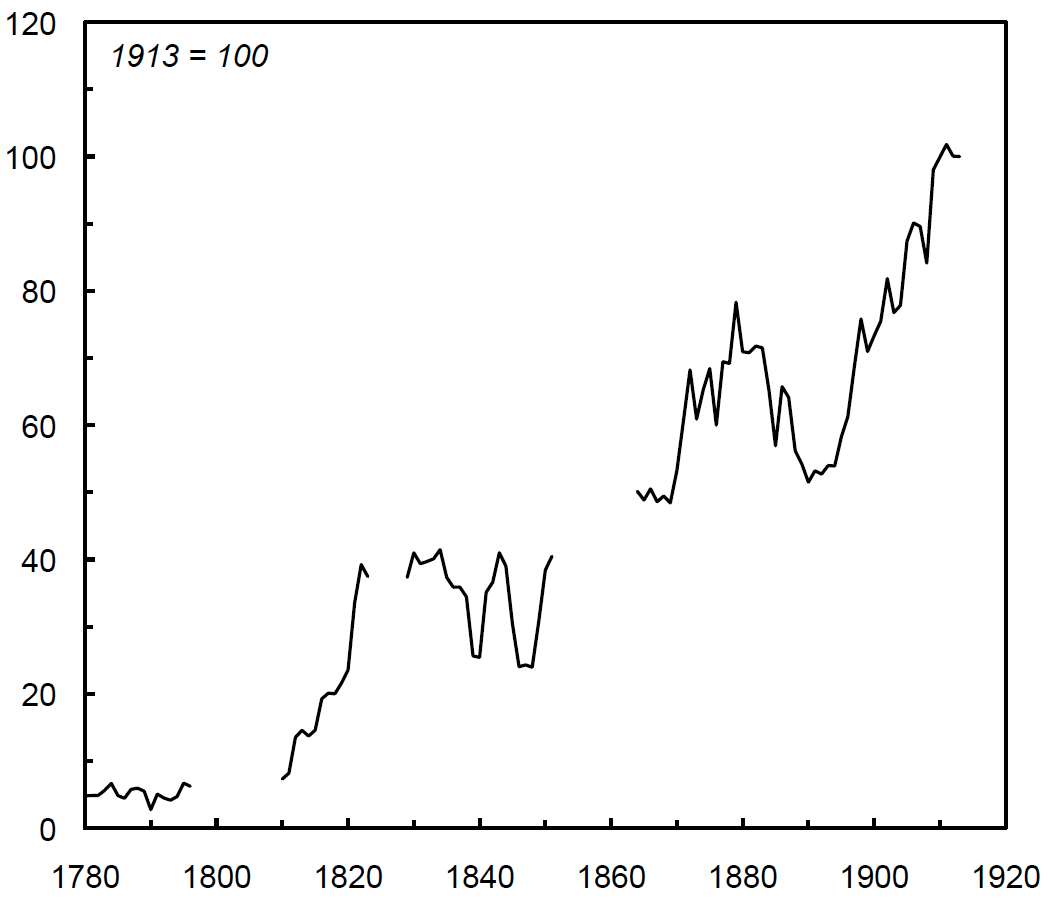Argentina’s terms of trade probably improved by more than 2,000 percent during the long nineteenth century.
In a new working paper I report the most important finding of my PhD dissertation. In ‘Resolving the Halperín Paradox: The Terms of Trade and Argentina’s Expansion in the Long Nineteenth Century’ I show that Argentina’s terms of trade improved dramatically during the long nineteenth century.
The paper’s starting point is Tulio Halperín Donghi’s observation that there were no price incentives for the pastoral expansion that took place on the Argentine Pampas in the first half of the nineteenth century. This is the ‘Halperín paradox’, which has seen other historians attempt to explain why the expansion took place despite the lack of price incentives. In my paper I argue that this research agenda is misguided.
The basis for the Halperín paradox can be seen in Figure 1, which is reproduced from Halperín Donghi’s (1963, p. 63) classic article on the pastoral expansion. The solid line shows the prices of River Plate hides in London, while the dashed line is the quantity of River Plate hides imported into Britain. As can be seen, there is a negative correlation between them: the hides imported tended to increase, while their prices fell. Taking these as representative of trends in the River Plate itself, Halperín Donghi (1963, p. 61) concluded that the pastoral expansion was not due to price incentives because, as he put it, his numbers ‘perfectly demonstrate the economic climate in which pastoral production occurred in the whole River Plate area (and, for that reason, also in the countryside of Buenos Aires); [it was] a production that did not receive its stimulus, nor see its momentum hampered, by movements in prices’ (my translation).
Figure 1
Halperín Donghi’s Paradox: River Plate Hide Prices and Exports (in London)
Source: Halperín Donghi (1963, p. 63).
Halperín Donghi’s conclusion was based on two methodological errors:
- He looked at nominal prices whereas what matters are relative prices. If, for instance, hide prices fall by 20 percent but the prices of manufactured goods fall by 80 percent, there is a big incentive to move out of manufacturing and into ranching.
- He looked at prices in London and not prices in the River Plate. This is crucial because there was massive price convergence globally during the nineteenth century, so the trend of prices in one place are unlikely to be representative of the trend of prices in another.
Carlos Newland (1998; also Newland and Ortiz 2001)) has done much to correct the first of Halperín Donghi’s errors by looking at Argentina’s terms of trade – that is, the prices of its exports relative to its imports. However, even he has done little to address the second error, as Newland continued to rely upon foreign prices as proxies for Argentina’s own prices. That is where my new paper comes in.
In the working paper I reconstruct Argentina’s nineteenth-century export prices from a variety of sources, then deflate them by a weighted average of the export price indices of Argentina’s trade partners, which acts as a crude proxy for its import prices. The resulting ‘part-proxy’ terms-of-trade index can be seen in Figure 2.
Figure 2
Argentina’s Part-Proxy Terms of Trade, 1780-1913

Source: Francis (2014, p. 10, Figure 2).
My new series suggests a far greater terms-of-trade boom than has previously been supposed. The standard series, which combines Newland’s estimate with that of Alec Ford (1955), suggests an improvement of 152 percent from the 1810s to the 1900s, whereas my series suggests 441 percent. Looking further back, it shows a 1,451 percent improvement from the 1780s to the 1900s. Even this, moreover, is likely to be an underestimate, as it does not take into the effects of price convergence on the import side. Simple adjustments to the proxy import price index suggest that the increase was probably well over 2,000 percent.
This finding resolves the Halperín paradox. There were massive price incentives for the expansion on the Pampas, so alternative explanations are not required. In the paper I suggest that future research should focus more on the less beneficial effects of the boom on Argentina’s relatively land-scarce Interior.
References
Ford, A.G., ‘Export Price Indices for the Argentine Republic, 1881-1914’, Inter-American Economic Affairs, 9:2, 1955, pp. 42-54.
Halperín Donghi, T., ‘La expansión ganadera en la campaña de Buenos Aires (1810-1852)’, Desarrollo Económico, 3:1/2, 1963, pp. 57-110.
Newland, C., ‘Exports and Terms of Trade in Argentina, 1811-1870’, Bulletin of Latin American Research, 17:3, 1998, pp. 409-16.
Newland, C., and J. Ortíz, ‘The Economic Consequences of Argentine Independence’, Cuadernos de Economía, 38:115, 2001, pp. 275-90.

Hi Joe,
I’m an undergraduate economics student at Universidad Torcuato Di Tella. I read your article with interest. I can’t grasp how your methodology adresses the question you were asking about relative prices. I mean: you reconstruct the series for terms of trade, but, as I got it, you were suggesting pastoral expansion occured because relative prices between goods that could be produced locally changed. shouldn’t you watch the prices of different locally – produced goods? which do you think these were at the time?
Thanks!
Marcos
Hi Marcos,
I’m suggesting that the pastoral expansion occurred because there was a dramatic improvement in the prices of pastoral products relative to imported goods. This is why they began to bring the Pampas land into production – before the terms-of-trade boom, it was not sufficiently profitable to do so.
Does that answer your question?
Best,
Joe
Pingback: Economic History Link Dump 15-01-2015 | Pseudoerasmus